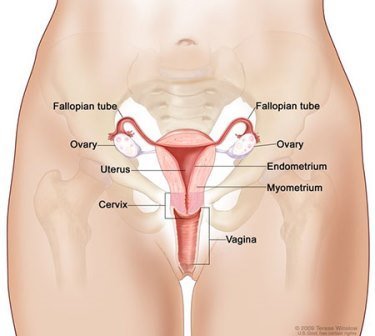
Endometrial cancer is a disease where malignant cells form in the tissues of the endometrium. But before knowing more about this disease and its novel treatment I think it is necessary to know that the female reproductive system is composed of the uterus, ovaries, fallopian tubes, cervix and vagina. The uterus is a hollow organ that has an outer muscular layer called myometrium and an inner lining that becomes the endometrium.

Endometrial carcinoma, also known as endometrial cancer, originates when the endometrial cells begin to grow uncontrollably. The main signs and symptoms of this disease include abnormal vaginal bleeding or pain in the pelvis.
It is important to consult a doctor if the following symptoms occur:
- Vaginal bleeding or discharge not related to menstruation (periods).
- Vaginal bleeding after menopause.
- Difficulty or pain when urinating.
- Pain during sexual intercourse.
- Pain in the pelvic area.
Tests that examine the endometrium are used to detect and diagnose endometrial cancer:
Since endometrial cancer begins inside the uterus, it usually does not appear in the results of a Test of Pap. For this reason, a sample of the endometrial tissue should be removed and examined under a microscope to detect cancer cells. You can use one of the following procedures:
- Endometrial biopsy: removal of tissue from the endometrium (inner lining of the uterus) by inserting a thin, flexible tube through the cervix into the uterus. The tube is used to gently scrape a small amount of tissue from the endometrium and then remove the tissue samples. A pathologist observes the tissue under a microscope to check for cancer cells.
- Dilation and curettage: procedure to remove tissue samples from the lining of the uterus. The cervix is dilated and a curette (spoon-shaped instrument) is inserted into the uterus to remove the tissue. Tissue samples are checked for microscopic observation and for signs of disease. This procedure is also called DyL.

Endometrial carcinoma is a common cause of death due to gynecological cancer. The most frequent therapeutic approach is the surgical removal of the uterus (total abdominal hysterectomy) and its annexes (bilateral salpingo-oophorectomy), which includes ovaries and fallopian tubes, but to avoid this type of intervention, a treatment based on nano particles to tackle the affected area.
It is a therapy with nanoparticles that contain two anticancer drugs which selectively destroy the cancer cells located in the endometrium.

It has been demonstrated that one of the most aggressive types of cancer in women is endometrial cancer, it is a uterine serous carcinoma and it is identified as showing deficient results, especially due to the resistance it shows against conventional chemotherapy drugs. Scientists from the Faculty of Pharmacy at the University of Iowa (United States), has developed a new treatment approach, which adds nano-particles loaded with a drug which makes cancer cells more sensitive to the toxicity of chemotherapy.
In these studies carried out the researchers of the University of Iowa, combined traditional chemotherapy with a new drug that is used for cancer, this treatment consisted of loading small nano-particles directly into the tumor cells resistant to chemotherapy, this novel treatment is extremely selective and lethal for endometrial cancer.
In disagreement with chemotherapy, the current treatment against cancer that exposes the whole body to the effects of medications, these targeted procedures are administered directly in the area where the tumor is located, which improves the efficacy of the drug by protecting the tissue and the organs that are healthy. The researchers joined forces to create this highly selective treatment against cancer, for that reason they aimed at the nano-particles.
For this reason, interest in the use of nanoparticles to treat cancer has increased, and this is due to its small size. The tumors grow rapidly and the blood vessels they create to fuel their development are defective and full of holes. The nano-particles are small enough to slip through those holes, allowing them to act directly on the tumors.
Using this fragility, the scientists used nano-particles containing paclitaxel, a chemotherapy widely used in the treatment of endometrial cancer and nintedanib, used to limit the development of blood vessels of the tumor, but which also intervenes against tumor cells carrying a tumor. mutation called "loss of p53 function", which makes them more resistant to the action of chemotherapy.
Dr. Kareem Ebeid, from the Division of Pharmacy and Translational Therapeutics at the UI Faculty of Pharmacy and co-author of the study, commented: "Basically, we are taking advantage of the Achilles heel of tumor cells (mutation of loss of function ) and then we eliminate them with chemotherapy. We call this a synthetically lethal situation because we are creating the right conditions for a massive death of cancer cells. ".
Nanotechnology against cancer:
This would not be the first time that nanotechnology is used to fight cancer, recently results of studies have been published in which gold nanoparticles had been used to prevent the malignant cells of the original tumor from migrating to other parts of the body causing metastasis.
Also, another significant advantage that scientists have wanted to highlight in this research, is that this treatment could be used in other neoplasms in which the mutation "loss of p53 function" is also present, as occurs in cancer. Lung or ovarian cancer, and since the medications they have used are already approved for clinical use, they hope to test nano-particles in patients in a short period of time.

If you liked my post ...

Very true, thanks for your comment.
Nice post! I will follow you from now on.
Thank you very much, I also follow you to know your post.